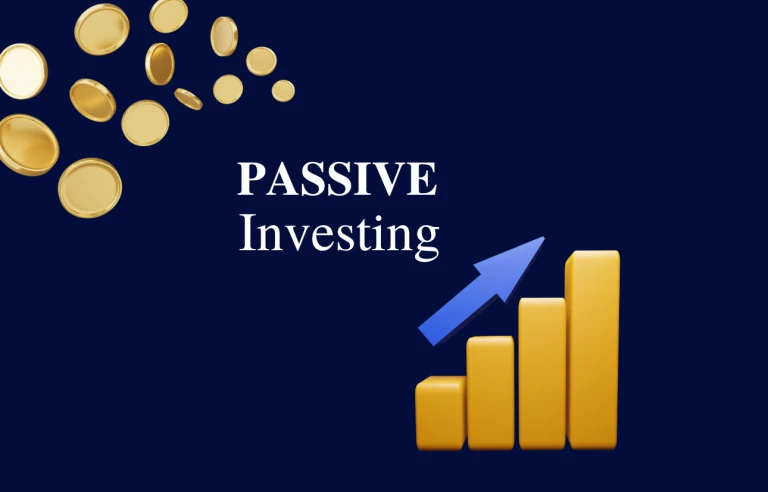What is Passive Investing?

The term “passive investing” refers to an investment strategy that involves building a portfolio with holdings that are comparable to those of an underlying index, such as the S&P BSE Sensex, NSE Nifty50, or a commodity, such as gold. When investing passively, investors make investments to replicate the performance of the underlying index or commodity. In this case, a single investment product gives investors direct exposure to both benchmarks and commodities. Exchange Traded Funds (ETFs) and Index Funds are two examples of financial products that use this type of investment strategy.
An overview of passive investing’s history
Although buying and holding stocks is not a modern technique, the first index fund for individual investors was developed in the 1970s, which marked the beginning of the passive investing movement.
When John C. Bogle, the then-CEO of The Vanguard Group, launched it in 1976, it was a completely new sort of mutual fund. The Vanguard 500 Index (VFINX), as it was known, allowed numerous investors to buy shares in a fund that mirrored the S&P 500, an index that is frequently used as a proxy for the entire stock market. It was priced lower than the majority of mutual funds, allowing “the little guy” to invest in some of the best-known companies without having to spend as much money or effort buying them separately.
The index mutual funds were offered by all the other businesses in a similar fashion. Then, in 1990, exchange-traded funds were introduced as a new invention (ETFs). They, too, were created to follow various indices, and their management costs were far lower than those of mutual funds. Additionally, there is more liquidity because ETFs trade continuously throughout the day on exchanges, much like equities do.
They were designed for a buy-and-hold strategy and vice versa, being extremely affordable, diversified, and lower-risk. Passive investing became a topic of discussion in the financial world with the introduction of ETFs, particularly among retail investors.
How to Invest in Passive Funds?
Research
Finding the right fund requires study as the first step in starting a passive investment strategy. There are currently more than a hundred passive funds available on the Indian Stock Market; you should pick the one that best matches your financial situation and investment goals. You can investigate the funds based on the sector, for instance, if you’re looking for a sector-based passive fund, on websites like grow, zerodha.com, Money Control, or any other platform of your choice.
Invest Offline
If you enjoy investing generally, you can visit the fund house with your documentation and register for a SIP or a one-time investment plan. If you must invest offline, you will need a cancelled check, documentation of your residence and identification, and a few photos.
Investing through Apps
There are many applications available today in the Indian market that simplify investing in the passive market. Installing the app and finding the appropriate passive fund that is worthy of your investment are prerequisites at first. Your investment is simply a few button clicks away once you’ve finished creating the app and are on the lookout for the passive fund.
App-based investing is a much superior option because it allows for quick tracking of your investments. Additionally, because these applications don’t charge you any money to manage your relationship with the fund house regarding investments, investing using apps is significantly more affordable.
Advantages of passive Investing
Lower Costs
When compared to actively managed funds, passively managed investment products like ETFs, index funds, etc. typically have considerably lower expense ratios. This occurs because, given the requirement to solely track changes in benchmark composition, the investment team has a very small role to play in terms of stock selection and timing investment transactions. As a result, the fund management fees and transaction costs are extremely low, which lowers the costs for investors.
Diversification
Investing with a passive investment plan offers the same benefits of diversification across the market segments through a single investment product because benchmark indices are constructed to have an overall market representation, comprising multiple sectors and market segments.
Elimination of unsystematic risk
Systematic risk primarily refers to the risk of market fluctuations caused by changes in the macroeconomic indices, such as economic growth, current account deficit, etc. Risks other than systematic risks are referred to as unsystematic risks. It is the danger of choosing the wrong financial products or investing in mutual funds at the wrong time. These risks are reduced for investors because the passive investing plan does not give fund managers this level of flexibility.

Disadvantages of Passive Investing
Although passive investing offers numerous advantages, it also has some drawbacks.
Live by the benchmark, die by the benchmark.
Index funds follow their benchmark index regardless of the state the market is in at any one time. Meaning: They will automatically rise when the indices are performing well and fall when prices are falling. And if the market plummets without warning…
Lack of flexibility
Despite anticipating a fall in their benchmark’s performance. Index fund managers typically do not take measures like reducing the number of shares they own or adopting a defensive, counterbalancing position in other assets.
Fewer windfalls
Because passive funds are designed to mimic the market. Investors are unlikely to benefit from the large gains that actively managed funds can occasionally provide. In other words, don’t try to catch that rising stock star. Even if a fund did, the benefits may be limited. Because the returns would be offset by other holdings in the portfolio.
Less pain, but less gain
Buying and holding can be a great long-term strategy (at least a decade or two). You deal with market volatility. However, avoiding the risks flattens out the rewards. Active investing produces better results and larger gains over shorter time periods.
Follow us on Instagram.









